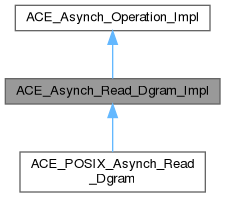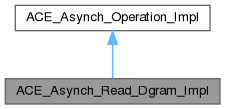Abstract base class for all the concrete implementation classes that provide different implementations for the ACE_Asynch_Read_Dgram. More...
#include <Asynch_IO_Impl.h>


Public Member Functions | |
| virtual | ~ACE_Asynch_Read_Dgram_Impl ()=default |
| virtual ssize_t | recv (ACE_Message_Block *message_block, size_t &number_of_bytes_recvd, int flags, int protocol_family, const void *act, int priority, int signal_number)=0 |
 Public Member Functions inherited from ACE_Asynch_Operation_Impl Public Member Functions inherited from ACE_Asynch_Operation_Impl | |
| virtual | ~ACE_Asynch_Operation_Impl ()=default |
| virtual int | open (const ACE_Handler::Proxy_Ptr &handler_proxy, ACE_HANDLE handle, const void *completion_key, ACE_Proactor *proactor)=0 |
| virtual int | cancel ()=0 |
| virtual ACE_Proactor * | proactor () const =0 |
| Return the underlying proactor. | |
Protected Member Functions | |
| ACE_Asynch_Read_Dgram_Impl ()=default | |
 Protected Member Functions inherited from ACE_Asynch_Operation_Impl Protected Member Functions inherited from ACE_Asynch_Operation_Impl | |
| ACE_Asynch_Operation_Impl ()=default | |
Detailed Description
Abstract base class for all the concrete implementation classes that provide different implementations for the ACE_Asynch_Read_Dgram.
Constructor & Destructor Documentation
◆ ~ACE_Asynch_Read_Dgram_Impl()
|
virtualdefault |
◆ ACE_Asynch_Read_Dgram_Impl()
|
protecteddefault |
Member Function Documentation
◆ recv()
|
pure virtual |
This starts off an asynchronous read. Upto <message_block->total_size()> will be read and stored in the message_block. message_block's <wr_ptr> will be updated to reflect the added bytes if the read operation is successful completed. Return code of 1 means immediate success and <number_of_bytes_recvd> will contain number of bytes read. The <ACE_Handler::handle_read_dgram> method will still be called. Return code of 0 means the IO will complete proactively. Return code of -1 means there was an error, use errno to get the error code.
Scatter/gather is supported on WIN32 by using the <message_block->cont()> method. Up to ACE_IOV_MAX message_block's are supported. Upto <message_block->size()> bytes will be read into each <message block> for a total of <message_block->total_size()> bytes. All message_block's <wr_ptr>'s will be updated to reflect the added bytes for each message_block
Priority of the operation is specified by priority. On POSIX4-Unix, this is supported. Works like <nice> in Unix. Negative values are not allowed. 0 means priority of the operation same as the process priority. 1 means priority of the operation is one less than process. And so forth. On Win32, priority is a no-op. signal_number is the POSIX4 real-time signal number to be used for the operation. signal_number ranges from ACE_SIGRTMIN to ACE_SIGRTMAX. This argument is a no-op on non-POSIX4 systems.
Implemented in ACE_POSIX_Asynch_Read_Dgram.
The documentation for this class was generated from the following file: